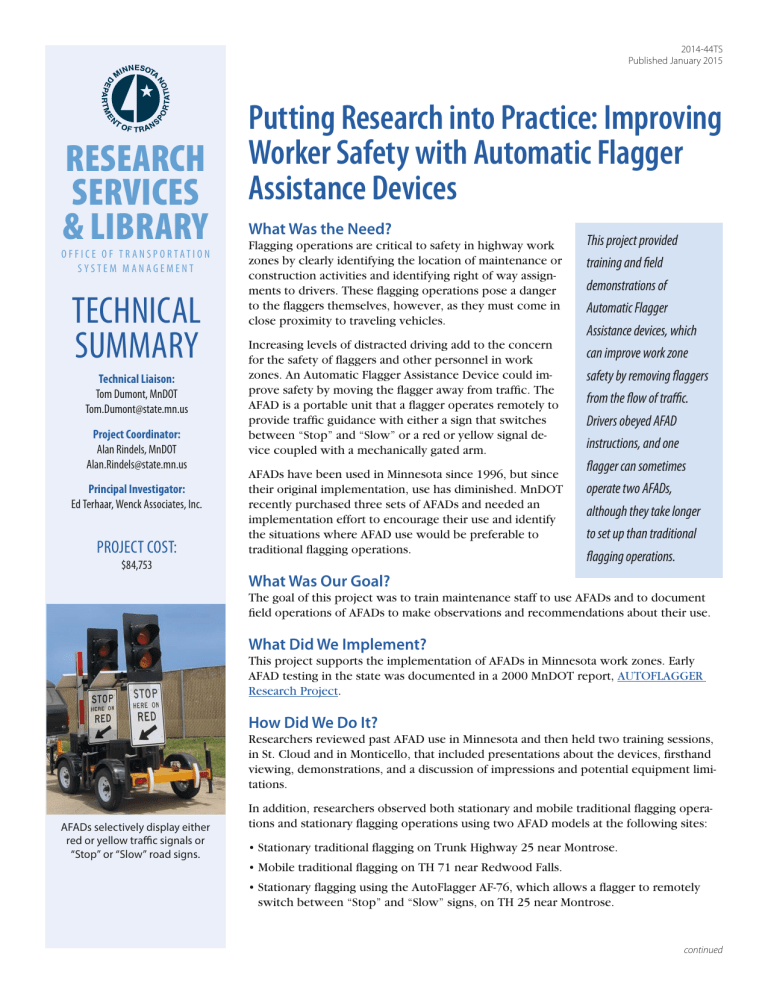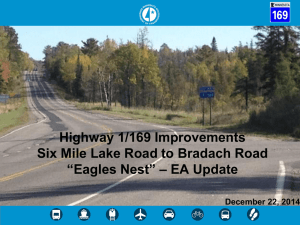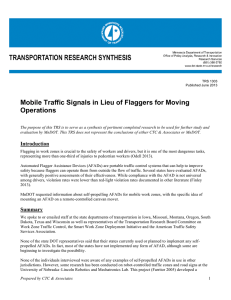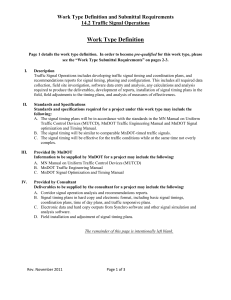RESEARCH SERVICES & LIBRARY Putting Research into Practice: Improving

RESEARCH
SERVICES
& LIBRARY
O F F I C E O F T R A N S P O R T A T I O N
S Y S T E M M A N A G E M E N T
TECHNICAL
SUMMARY
Technical Liaison:
Tom Dumont, MnDOT
Tom.Dumont@state.mn.us
Project Coordinator:
Alan Rindels, MnDOT
Alan.Rindels@state.mn.us
Principal Investigator:
Ed Terhaar, Wenck Associates, Inc.
PROJECT COST:
$84,753
AFADs selectively display either red or yellow traffic signals or
“Stop” or “Slow” road signs.
2014-44TS
Published January 2015
Putting Research into Practice: Improving
Worker Safety with Automatic Flagger
Assistance Devices
What Was the Need?
Flagging operations are critical to safety in highway work zones by clearly identifying the location of maintenance or construction activities and identifying right of way assignments to drivers. These flagging operations pose a danger to the flaggers themselves, however, as they must come in close proximity to traveling vehicles.
Increasing levels of distracted driving add to the concern for the safety of flaggers and other personnel in work zones. An Automatic Flagger Assistance Device could improve safety by moving the flagger away from traffic. The
AFAD is a portable unit that a flagger operates remotely to provide traffic guidance with either a sign that switches between “Stop” and “Slow” or a red or yellow signal device coupled with a mechanically gated arm.
AFADs have been used in Minnesota since 1996, but since their original implementation, use has diminished. MnDOT recently purchased three sets of AFADs and needed an implementation effort to encourage their use and identify the situations where AFAD use would be preferable to traditional flagging operations.
This project provided training and field demonstrations of
Automatic Flagger
Assistance devices, which can improve work zone safety by removing flaggers from the flow of traffic.
Drivers obeyed AFAD instructions, and one flagger can sometimes operate two AFADs, although they take longer to set up than traditional flagging operations.
What Was Our Goal?
The goal of this project was to train maintenance staff to use AFADs and to document field operations of AFADs to make observations and recommendations about their use.
What Did We Implement?
This project supports the implementation of AFADs in Minnesota work zones. Early
AFAD testing in the state was documented in a 2000 MnDOT report, AUTOFLAGGER
Research Project .
How Did We Do It?
Researchers reviewed past AFAD use in Minnesota and then held two training sessions, in St. Cloud and in Monticello, that included presentations about the devices, firsthand viewing, demonstrations, and a discussion of impressions and potential equipment limitations.
In addition, researchers observed both stationary and mobile traditional flagging operations and stationary flagging operations using two AFAD models at the following sites:
• Stationary traditional flagging on Trunk Highway 25 near Montrose.
• Mobile traditional flagging on TH 71 near Redwood Falls.
• Stationary flagging using the AutoFlagger AF-76, which allows a flagger to remotely switch between “Stop” and “Slow” signs, on TH 25 near Montrose.
continued
“Maintenance workers are concerned that standing out on the roadway to flag is getting more and more dangerous because there are more distractions for drivers. Work crews are interested in trying to minimize their exposure on the roadway.”
—Tom Dumont,
MnDOT District 3
Traffic Engineer
“In the past, flaggers have been struck by vehicles.
AFAD technology removes flaggers from work zones to create a safer environment.”
—Ed Terhaar,
Principal Traffic Engineer,
Wenck Associates, Inc.
Produced by CTC & Associates for:
Minnesota Department of Transportation
Research Services & Library
MS 330, First Floor
395 John Ireland Blvd.
St. Paul, MN 55155-1899
651-366-3780 www.mndot.gov/research
MnDOT and district maintenance staff members examine the AutoFlagger AF-76 during the training session at MnDOT’s St. Cloud Training Center.
• Stationary flagging using the AutoFlagger AF-54, which allows the flagger to remotely switch between red and yellow lights, on TH 25 near Watertown.
Researchers also interviewed MnDOT maintenance personnel about their experiences.
What Was the Impact?
Sixty-one staff members attended the training sessions, representing MnDOT Districts 3 and 8 as well as the Metro District, which is where MnDOT’s newly purchased AFADs will be available for use. MnDOT also produced a video demonstrating AFAD operations.
In all four field observations, the operations were effective in directing traffic. At the two sites where AFADs were used, motorists understood and followed the devices’ instructions. It took maintenance personnel approximately 40 minutes to set up or take down the AFADs compared to 20 minutes to set up or take down traditional flagging operations. The AF-54 is narrower than the AF-76, which makes it suitable for roads with narrower shoulders.
Traditional flagging operations require a flagger at both ends of the operation communicating via handheld radios. In both AFAD demonstrations in this project, however, a single flagger operated both devices. In general, a pair of AFADs can sometimes be operated by a single person if the length and geography of the work zone allow a single operator to see both ends clearly.
Interviews with the work crews involved in the field operations revealed that AFADs function well for stationary projects, but there was concern about whether they would work in winter. Crew members also expressed the desire for AFADs suitable for mobile operations.
What’s Next?
This research serves as a demonstration that should encourage the use of the AFADs that MnDOT has purchased. MnDOT has planned a project to determine whether it is feasible to use a self-propelled device to push or pull an AFAD so it can be used in moving operations such as patching potholes or cracks, which make up more than half of
MnDOT’s flagging operations. For this to become a viable option, MnDOT also needs to determine if it would be legal to use moving AFADs under the Manual on Uniform Traffic Control Devices.
This Technical Summary pertains to Report 2014-44, “Implementation of Automatic Flagger
Assistance Devices (AFADs) for Minnesota Department of Transportation Flagger Operations,” published December 2014. The full report can be accessed at http://www.lrrb.org/PDF/201444.pdf
.








